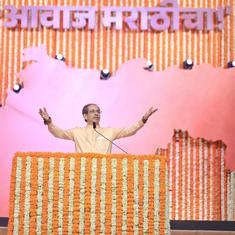The past few years have seen several changes of publishers and editors among India’s English-language publishing companies, but if there was one person who was always considered unshakeable from her post, it was Karthika VK, publisher at HarperCollins India. Which is why her resignation from that post is something of a shock.
The announcement of Karthika’s departure came almost exactly a year after the company got a new CEO in Ananth Padmanabhan, the former head of sales at Penguin India, in October 2015. He replaced PM Sukumar, who left after 11 years at the helm.
Inevitably, the questions have begun: why has Karthika, who joined HarperCollins India in 2006, chosen to quit after all these years? What has changed, forcing her to leave a company that she had become practically synonymous with in the industry and amongst writers, informed readers and the media? Naturally, none of the key players from the company is talking. The official statements, when they come, will be expectedly template-driven.With Karthika leaving, and her fellow publisher Krishan Chopra – also a 10-year veteran – retiring soon, Padmanabhan will now need to build a top editorial line afresh. Like any CEO, he may well pick people who are aligned to his vision for HarperCollins India.
It’s both easy and tempting to mount conspiracy theories when the publisher of a company leaves after 10 years, a year after a new CEO takes over. That Karthika, in the prime of her career as a publisher – with an extremely enviable track record when it comes to quality fiction, non-fiction, graphic novels and poetry – has chosen to give up her association with HarperCollins clearly points to a divergence in viewpoints.But the real issue here is not so much a clash between individual perspectives as it is between two approaches to English-language publishing in India. And it isn’t difficult to read into Karthika’s departure the transition of HarperCollins India – don’t forget, it’s part of Rupert Murdoch’s business empire – from one model to another.
An enviable record
Over the past few years, almost no publishing company in India can claim the kind of critical success that HarperCollins has. With the exception of marquee stars like Amitav Ghosh, Ramachandra Guha, Vikram Seth and, now, Arundhati Roy, it has the virtual who’s who of English-language writers – both fiction and non-fiction – from the country. Consider these names, among many others:
Aravind Adiga. Altaf Tyrewala. Amitabha Bagchi. Amruta Patil. Anita Nair. Anuja Chauhan. Annie Zaidi. Arundhathi Subramaniam. Ashok Srinivasan. Bahar Dutt. Boria Majumdar. Chandrahas Choudhury. Gulzar. Hartosh Singh Bal. K Satchinandan. Karthika Nair. Kiran Nagarkar. Keki N Daruwala. Kishalay Bhattacharjee. Kishwar Desai. MJ Akbar. Mahesh Rao. Manu Joseph. Meena Kandasamy. Meghnad Desai. Mridula Koshi. Mukul Kesavan. Nayantara Sehgal. Nilanjana Roy. Pallavi Aiyar. Raghu Karnad. Ritu Menon. Rohini Mohan. Sankarshan Thakur. Sarnath Banerjee. Sudeep Chakravarti. TM Krishna. Upamanyu Chatterjee. Vivek Shanbagh.
At the risk of resembling a roster, even this selective list of the writers whom Karthika has brought into HarperCollins and published shows how powerful the company’s arsenal of writers is. Add to that the energy with which she has published graphic novels and poetry – practically the only publisher to do this on a sustained and regular basis – and piloted some of the finest writing on politics, current affairs and history – and the scale of the company’s achievements on a critical scale become evident. HarperCollins books have also won literary awards on a consistent basis.
What’s more, Karthika is known for the personal relationships of empathy, trust and camaraderie she has with the writers whom she publishes. This is an asset that resides very strongly with an individual rather than a company, and it is something that HarperCollins may well miss in her absence.Business versus quality
If, despite such a list, HarperCollins has to find other ways to be a successful business, it talks loud and clear about the predicament of publishing in India today. It is almost a tragedy that a steady stream of critically acclaimed, innovative, and award-winning books is not enough for a publishing firm to do well. The ground realities point to a different picture altogether.
With the vast change in the demographics, the overwhelming presence of people below 30 means that reading books is no longer a natural, organic activity – there has to be a reason to read a book. And in this segment, it is campus and corporate romances that rule.
As for non-fiction, the emphasis is on utility, through personal guides and self-help books, in areas like entrepreneurship, personality-development, health, spirituality, food, and beauty, among others. To tap into these veins, a publishing company really has to reinvent itself as a purveyor of information and entertainment, rather than the now old-fashioned notion of producing immersive books that add to our understanding and enjoyment of the world and the human condition.
It’s not difficult to see the pressures the CEO of a publishing company has to operate under. With the average print-run of books down to 3,000 or fewer copies, a company has to produce a great many number of books to reach its targets. And even so, some of them have to be big sellers, and a few, blockbusters. All of which means publishing to the market, following trends, and chasing potential bestselling writers.And that is the larger picture that Karthika’s exit from HarperCollins throws into relief today. The future of publishing is being created right now. And the old ways of doing things may no longer work for multinational publishers. The change of tack is already evident at Penguin Random House. Now HarperCollins may follow suit.










